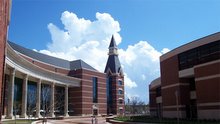 This is the second in a series of status reports on the Baylor 2012 initiatives. The implementation of Imperative II has been quite impressive. Much credit for this must be given to Dr. Frank Shushok, Jr., the Dean for Student Learning & Engagement. Thank you Dr. Shushok for your diligent labors in this regard!
This is the second in a series of status reports on the Baylor 2012 initiatives. The implementation of Imperative II has been quite impressive. Much credit for this must be given to Dr. Frank Shushok, Jr., the Dean for Student Learning & Engagement. Thank you Dr. Shushok for your diligent labors in this regard!One of the most obvious benefits of the implementation of Imperative II is related to the number of students who live on campus. In 2001, approximately 3,600 students resided in university housing. With the opening of the North Village in 2004, the number increased to approximately 4,200. When Brooks Village opens this fall, approximately 4,600 students will live at Baylor! Almost all the growth in university housing has been among upper-division students. About 1,200 upper-division students have already contracted to live on-campus next year. By the time it’s all said and done, over 1,500 upper-division students will call a Baylor residential community home this fall. This is a radical shift from the most recent Baylor past.
The number of student participating in a living-learning community has also be on an impressive upward trend. In 2004, the first-year of living-learning environments at Baylor, 460 students were a part of one of these communities. This fall, the number reached 588 students. Over 1,000 students are expected to participate in a living-learning environment next fall. The choices range from the Engineering/Computer Science Living-Learning Center, the Leadership Living-Learning Center, the Honors College Living-Learning Center, the Outdoor Adventure Living-Learning Center or Brooks Residential College. These endeavors not only help students bridge their academic and co curricular lives, they also offer students a variety of housing options and a new potential way to “find community” at Baylor.
The May/June 2006 edition of the Talking Stick, the professional magazine for the Association for College and University Housing Officers-International, featured Building character: A celebration of hallowed halls. As part of this story, Baylor’s North Village was selected as one of sixteen residence halls to be included alongside the University of Virginia, MIT, Notre Dame, Princeton, Duke, and Penn among others. This falls on the heals of the North Village being featured on the cover of the June, 2005 issue of College Planning & Management Magazine and being designated the 2005 educational facility of the year.
Interest in Baylor’s model of living-learning centers has received much attention from other campuses and has resulted in several site visits to Baylor. Two campuses, for example, brought teams to Baylor this fall to look at what’s happening here. The Collegiate Way web site ( Link Here )(Note: Web site takes time to load) has featured Baylor’s progress toward the opening of Brooks Residential College on numerous occasions throughout the year.
One of the most exciting efforts underway is the creation of residential communities that are diverse in everyway, including having faculty members live in residence. This year three faculty members (Cindy Fry, Julie Sweet, Tom Riley and Xin Wang) served as faculty members in residence. All of these individuals are returning to these roles in 2007 where they will be joined by as many as six more faculty members living in residence. When Brooks Village opens in 2007, it is projected that seventeen faculty members will also office in the residence halls. In 2001, there were no faculty members in residence or with offices in the residence halls. This change represents marked progress toward integrating academic culture into the day to day life of residential living at Baylor.
One of the important ways Campus Living & Learning facilitates conversations about issues of diversity is by recruiting and hiring a diverse professional and student staff. As part of carefully evaluating a candidate’s capacity to advance the missions of Baylor, Student Life, and Campus Living & Learning, particular efforts are made to evaluate a candidate’s potential to connect with the breadth and diversity of students served in Baylor residence halls. Both the professional and student staffs represent Baylor students in an increasingly effective way. The number of students submitting applications to serve as a residence hall community leader has increased dramatically. In 2001, 111 students applied for positions compared to the most recent selection process consisting of well over 300 interested students.
Since developing friendships across demographic variables such as racial, religious tradition or socio-economic backgrounds is one of the most powerful ingredients to student’s learning, Campus Living & Learning is in its third year of implementing a strategy to correct unintentional but systemic practices that have segregated the residence halls (see: Related Lariat Article here). These efforts ensure that each first-year residence hall represents the diversity of the Baylor students as a whole, as well as affords students optimal opportunities for learning. As part of an initiative coined “Dialogues of Differences” Campus Living & Learning continues to host discussions and forums that address topics related to diversity. These include issues pertinent to the Waco community, socio-economic concerns, poverty, and religious intolerance.
Spiritual formation of students remains a top priority for campus housing and resident chaplains are now in most of Baylor's residential communities. In 2001, of course, these positions didn’t exist.
Those interested in more about these and other related matters might find it helpful to read the “In the News” section of the Campus Living & Learning web site. Campus Living & Learning In the News


No comments:
Post a Comment